Xue Lin
RoRA: Efficient Fine-Tuning of LLM with Reliability Optimization for Rank Adaptation
Jan 08, 2025



Abstract:Fine-tuning helps large language models (LLM) recover degraded information and enhance task performance.Although Low-Rank Adaptation (LoRA) is widely used and effective for fine-tuning, we have observed that its scaling factor can limit or even reduce performance as the rank size increases. To address this issue, we propose RoRA (Rank-adaptive Reliability Optimization), a simple yet effective method for optimizing LoRA's scaling factor. By replacing $\alpha/r$ with $\alpha/\sqrt{r}$, RoRA ensures improved performance as rank size increases. Moreover, RoRA enhances low-rank adaptation in fine-tuning uncompressed models and excels in the more challenging task of accuracy recovery when fine-tuning pruned models. Extensive experiments demonstrate the effectiveness of RoRA in fine-tuning both uncompressed and pruned models. RoRA surpasses the state-of-the-art (SOTA) in average accuracy and robustness on LLaMA-7B/13B, LLaMA2-7B, and LLaMA3-8B, specifically outperforming LoRA and DoRA by 6.5% and 2.9% on LLaMA-7B, respectively. In pruned model fine-tuning, RoRA shows significant advantages; for SHEARED-LLAMA-1.3, a LLaMA-7B with 81.4% pruning, RoRA achieves 5.7% higher average accuracy than LoRA and 3.9% higher than DoRA.
Pruning Foundation Models for High Accuracy without Retraining
Oct 21, 2024


Abstract:Despite the superior performance, it is challenging to deploy foundation models or large language models (LLMs) due to their massive parameters and computations. While pruning is a promising technique to reduce model size and accelerate the inference, the traditional pruning techniques can hardly be applied for LLMs as they need to finetune the model on the full dataset with multiple epochs consuming massive data and hardware resources. To deal with this problem, post-training pruning methods are proposed to prune LLMs in one-shot without retraining. However, their accuracy after pruning may suffer from certain performance degradation due to the lack of retraining with massive data. To address this issue, in this paper, we first formulate the post-training problem for layer-wise LLM compression to simultaneously prune multiple weights in LLMs. Next, we provide an optimal solution for this problem and design our post-training pruning algorithm for both unstructured and semi-structured sparsity. Our extensive experiments demonstrate the superior performance of the proposed methods in comparison to SOTA baselines across various LLM families including transformer-based LLMs and Mamba-based LLMs. Code link: https://github.com/piuzha/APT
Rethinking Token Reduction for State Space Models
Oct 16, 2024



Abstract:Recent advancements in State Space Models (SSMs) have attracted significant interest, particularly in models optimized for parallel training and handling long-range dependencies. Architectures like Mamba have scaled to billions of parameters with selective SSM. To facilitate broader applications using Mamba, exploring its efficiency is crucial. While token reduction techniques offer a straightforward post-training strategy, we find that applying existing methods directly to SSMs leads to substantial performance drops. Through insightful analysis, we identify the reasons for this failure and the limitations of current techniques. In response, we propose a tailored, unified post-training token reduction method for SSMs. Our approach integrates token importance and similarity, thus taking advantage of both pruning and merging, to devise a fine-grained intra-layer token reduction strategy. Extensive experiments show that our method improves the average accuracy by 5.7% to 13.1% on six benchmarks with Mamba-2 compared to existing methods, while significantly reducing computational demands and memory requirements.
MoE-Pruner: Pruning Mixture-of-Experts Large Language Model using the Hints from Its Router
Oct 15, 2024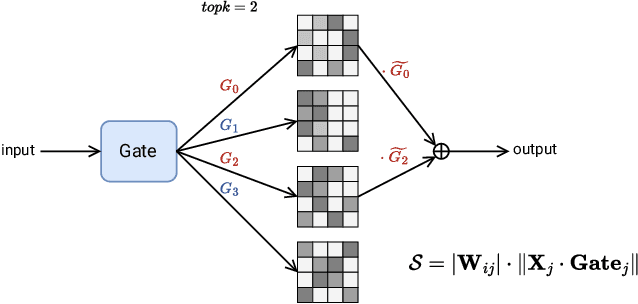

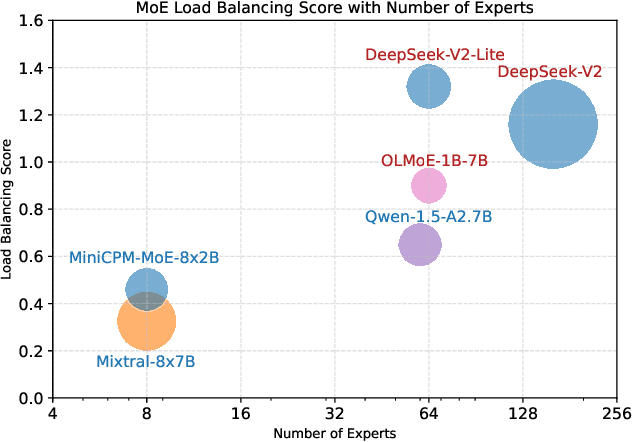
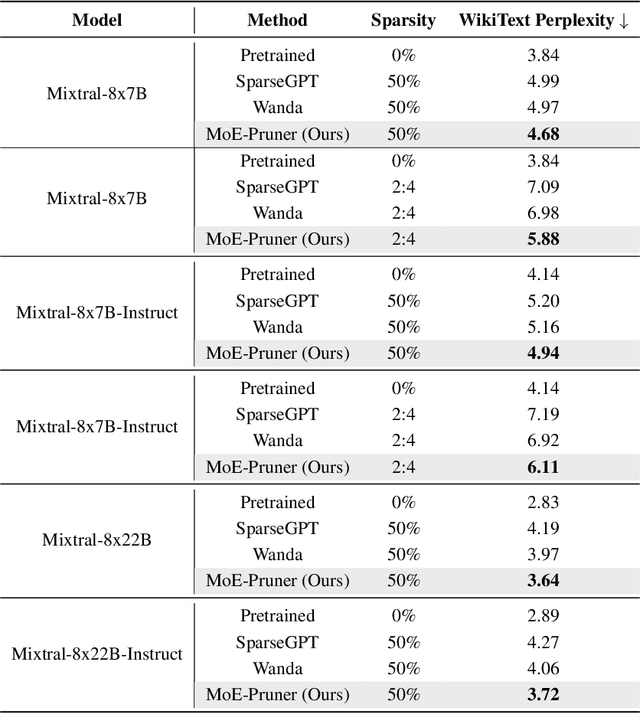
Abstract:Mixture-of-Experts (MoE) architectures face challenges such as high memory consumption and redundancy in experts. Pruning MoE can reduce network weights while maintaining model performance. Motivated by the recent observation of emergent large magnitude features in Large Language Models (LLM) and MoE routing policy, we propose MoE-Pruner, a method that prunes weights with the smallest magnitudes multiplied by the corresponding input activations and router weights, on each output neuron. Our pruning method is one-shot, requiring no retraining or weight updates. We evaluate our method on Mixtral-8x7B and Mixtral-8x22B across multiple language benchmarks. Experimental results show that our pruning method significantly outperforms state-of-the-art LLM pruning methods. Furthermore, our pruned MoE models can benefit from a pretrained teacher model through expert-wise knowledge distillation, improving performance post-pruning. Experimental results demonstrate that the Mixtral-8x7B model with 50% sparsity maintains 99% of the performance of the original model after the expert-wise knowledge distillation.
Brain Tumor Classification on MRI in Light of Molecular Markers
Sep 29, 2024



Abstract:In research findings, co-deletion of the 1p/19q gene is associated with clinical outcomes in low-grade gliomas. The ability to predict 1p19q status is critical for treatment planning and patient follow-up. This study aims to utilize a specially MRI-based convolutional neural network for brain cancer detection. Although public networks such as RestNet and AlexNet can effectively diagnose brain cancers using transfer learning, the model includes quite a few weights that have nothing to do with medical images. As a result, the diagnostic results are unreliable by the transfer learning model. To deal with the problem of trustworthiness, we create the model from the ground up, rather than depending on a pre-trained model. To enable flexibility, we combined convolution stacking with a dropout and full connect operation, it improved performance by reducing overfitting. During model training, we also supplement the given dataset and inject Gaussian noise. We use three--fold cross-validation to train the best selection model. Comparing InceptionV3, VGG16, and MobileNetV2 fine-tuned with pre-trained models, our model produces better results. On an validation set of 125 codeletion vs. 31 not codeletion images, the proposed network achieves 96.37\% percent F1-score, 97.46\% percent precision, and 96.34\% percent recall when classifying 1p/19q codeletion and not codeletion images.
* ICAI'22 - The 24th International Conference on Artificial Intelligence, The 2022 World Congress in Computer Science, Computer Engineering, & Applied Computing (CSCE'22), Las Vegas, USA. The paper acceptance rate 17% for regular papers. The publication of the CSCE 2022 conference proceedings has been delayed due to the pandemic
Pruning then Reweighting: Towards Data-Efficient Training of Diffusion Models
Sep 27, 2024Abstract:Despite the remarkable generation capabilities of Diffusion Models (DMs), conducting training and inference remains computationally expensive. Previous works have been devoted to accelerating diffusion sampling, but achieving data-efficient diffusion training has often been overlooked. In this work, we investigate efficient diffusion training from the perspective of dataset pruning. Inspired by the principles of data-efficient training for generative models such as generative adversarial networks (GANs), we first extend the data selection scheme used in GANs to DM training, where data features are encoded by a surrogate model, and a score criterion is then applied to select the coreset. To further improve the generation performance, we employ a class-wise reweighting approach, which derives class weights through distributionally robust optimization (DRO) over a pre-trained reference DM. For a pixel-wise DM (DDPM) on CIFAR-10, experiments demonstrate the superiority of our methodology over existing approaches and its effectiveness in image synthesis comparable to that of the original full-data model while achieving the speed-up between 2.34 times and 8.32 times. Additionally, our method could be generalized to latent DMs (LDMs), e.g., Masked Diffusion Transformer (MDT) and Stable Diffusion (SD), and achieves competitive generation capability on ImageNet.Code is available here (https://github.com/Yeez-lee/Data-Selection-and-Reweighting-for-Diffusion-Models).
Search for Efficient Large Language Models
Sep 25, 2024


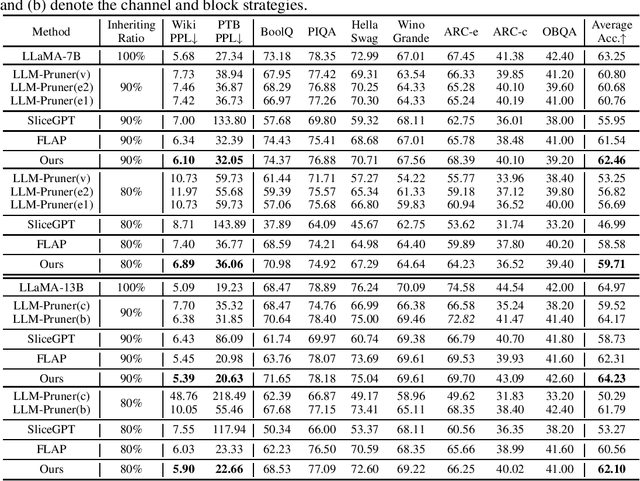
Abstract:Large Language Models (LLMs) have long held sway in the realms of artificial intelligence research. Numerous efficient techniques, including weight pruning, quantization, and distillation, have been embraced to compress LLMs, targeting memory reduction and inference acceleration, which underscore the redundancy in LLMs. However, most model compression techniques concentrate on weight optimization, overlooking the exploration of optimal architectures. Besides, traditional architecture search methods, limited by the elevated complexity with extensive parameters, struggle to demonstrate their effectiveness on LLMs. In this paper, we propose a training-free architecture search framework to identify optimal subnets that preserve the fundamental strengths of the original LLMs while achieving inference acceleration. Furthermore, after generating subnets that inherit specific weights from the original LLMs, we introduce a reformation algorithm that utilizes the omitted weights to rectify the inherited weights with a small amount of calibration data. Compared with SOTA training-free structured pruning works that can generate smaller networks, our method demonstrates superior performance across standard benchmarks. Furthermore, our generated subnets can directly reduce the usage of GPU memory and achieve inference acceleration.
Quasar-ViT: Hardware-Oriented Quantization-Aware Architecture Search for Vision Transformers
Jul 25, 2024

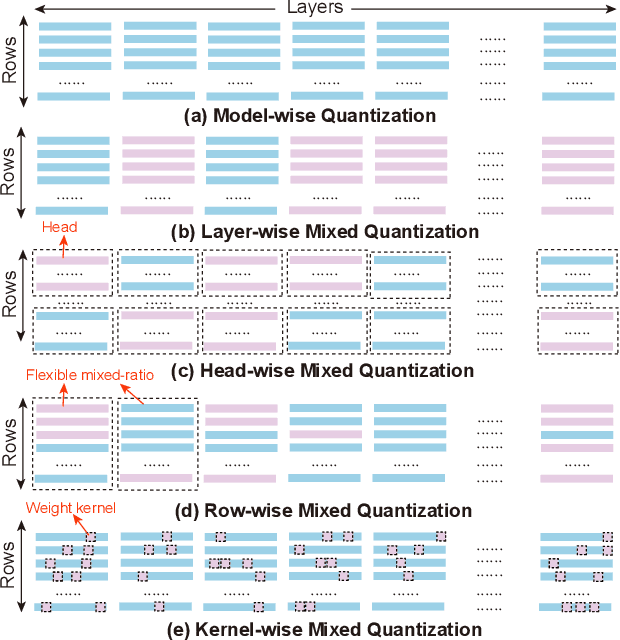

Abstract:Vision transformers (ViTs) have demonstrated their superior accuracy for computer vision tasks compared to convolutional neural networks (CNNs). However, ViT models are often computation-intensive for efficient deployment on resource-limited edge devices. This work proposes Quasar-ViT, a hardware-oriented quantization-aware architecture search framework for ViTs, to design efficient ViT models for hardware implementation while preserving the accuracy. First, Quasar-ViT trains a supernet using our row-wise flexible mixed-precision quantization scheme, mixed-precision weight entanglement, and supernet layer scaling techniques. Then, it applies an efficient hardware-oriented search algorithm, integrated with hardware latency and resource modeling, to determine a series of optimal subnets from supernet under different inference latency targets. Finally, we propose a series of model-adaptive designs on the FPGA platform to support the architecture search and mitigate the gap between the theoretical computation reduction and the practical inference speedup. Our searched models achieve 101.5, 159.6, and 251.6 frames-per-second (FPS) inference speed on the AMD/Xilinx ZCU102 FPGA with 80.4%, 78.6%, and 74.9% top-1 accuracy, respectively, for the ImageNet dataset, consistently outperforming prior works.
JIGMARK: A Black-Box Approach for Enhancing Image Watermarks against Diffusion Model Edits
Jun 06, 2024



Abstract:In this study, we investigate the vulnerability of image watermarks to diffusion-model-based image editing, a challenge exacerbated by the computational cost of accessing gradient information and the closed-source nature of many diffusion models. To address this issue, we introduce JIGMARK. This first-of-its-kind watermarking technique enhances robustness through contrastive learning with pairs of images, processed and unprocessed by diffusion models, without needing a direct backpropagation of the diffusion process. Our evaluation reveals that JIGMARK significantly surpasses existing watermarking solutions in resilience to diffusion-model edits, demonstrating a True Positive Rate more than triple that of leading baselines at a 1% False Positive Rate while preserving image quality. At the same time, it consistently improves the robustness against other conventional perturbations (like JPEG, blurring, etc.) and malicious watermark attacks over the state-of-the-art, often by a large margin. Furthermore, we propose the Human Aligned Variation (HAV) score, a new metric that surpasses traditional similarity measures in quantifying the number of image derivatives from image editing.
HybridFlow: Infusing Continuity into Masked Codebook for Extreme Low-Bitrate Image Compression
Apr 20, 2024

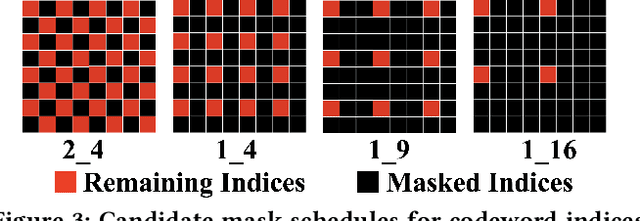

Abstract:This paper investigates the challenging problem of learned image compression (LIC) with extreme low bitrates. Previous LIC methods based on transmitting quantized continuous features often yield blurry and noisy reconstruction due to the severe quantization loss. While previous LIC methods based on learned codebooks that discretize visual space usually give poor-fidelity reconstruction due to the insufficient representation power of limited codewords in capturing faithful details. We propose a novel dual-stream framework, HyrbidFlow, which combines the continuous-feature-based and codebook-based streams to achieve both high perceptual quality and high fidelity under extreme low bitrates. The codebook-based stream benefits from the high-quality learned codebook priors to provide high quality and clarity in reconstructed images. The continuous feature stream targets at maintaining fidelity details. To achieve the ultra low bitrate, a masked token-based transformer is further proposed, where we only transmit a masked portion of codeword indices and recover the missing indices through token generation guided by information from the continuous feature stream. We also develop a bridging correction network to merge the two streams in pixel decoding for final image reconstruction, where the continuous stream features rectify biases of the codebook-based pixel decoder to impose reconstructed fidelity details. Experimental results demonstrate superior performance across several datasets under extremely low bitrates, compared with existing single-stream codebook-based or continuous-feature-based LIC methods.
 Add to Chrome
Add to Chrome Add to Firefox
Add to Firefox Add to Edge
Add to Edge